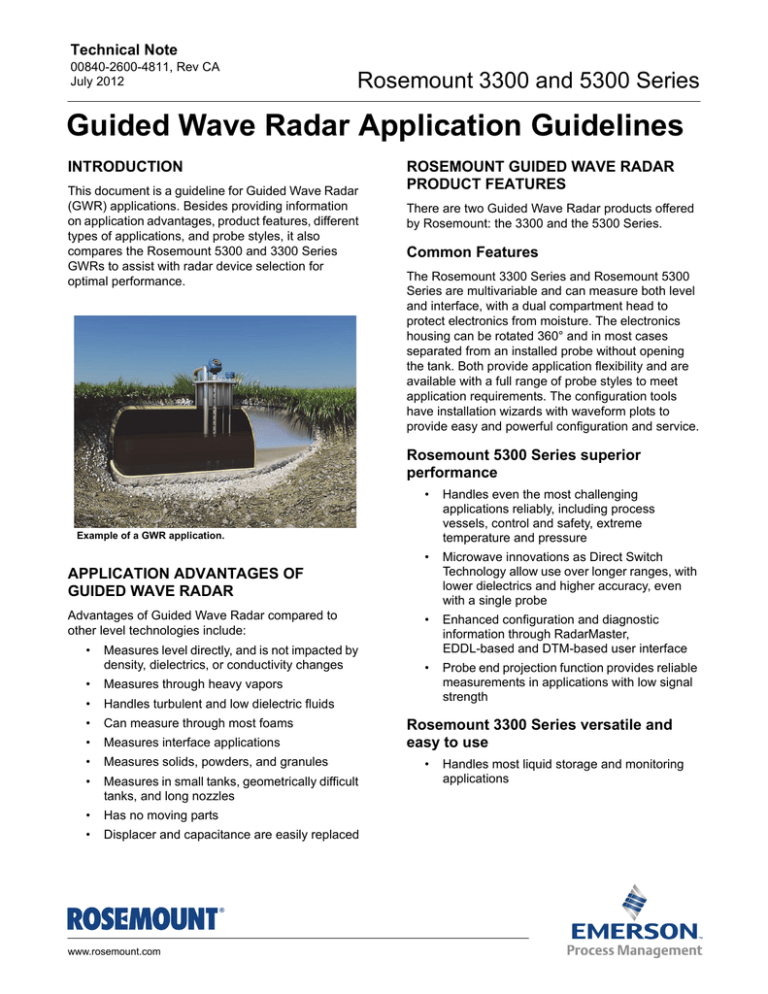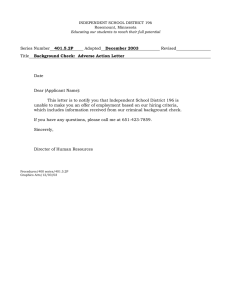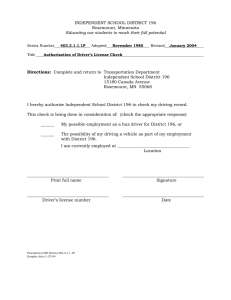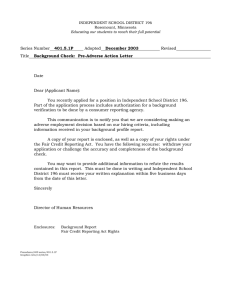
Technical Note
00840-2600-4811, Rev CA
July 2012
Rosemount 3300 and 5300 Series
Guided Wave Radar Application Guidelines
INTRODUCTION
This document is a guideline for Guided Wave Radar
(GWR) applications. Besides providing information
on application advantages, product features, different
types of applications, and probe styles, it also
compares the Rosemount 5300 and 3300 Series
GWRs to assist with radar device selection for
optimal performance.
ROSEMOUNT GUIDED WAVE RADAR
PRODUCT FEATURES
There are two Guided Wave Radar products offered
by Rosemount: the 3300 and the 5300 Series.
Common Features
The Rosemount 3300 Series and Rosemount 5300
Series are multivariable and can measure both level
and interface, with a dual compartment head to
protect electronics from moisture. The electronics
housing can be rotated 360° and in most cases
separated from an installed probe without opening
the tank. Both provide application flexibility and are
available with a full range of probe styles to meet
application requirements. The configuration tools
have installation wizards with waveform plots to
provide easy and powerful configuration and service.
Rosemount 5300 Series superior
performance
•
Handles even the most challenging
applications reliably, including process
vessels, control and safety, extreme
temperature and pressure
•
Microwave innovations as Direct Switch
Technology allow use over longer ranges, with
lower dielectrics and higher accuracy, even
with a single probe
•
Enhanced configuration and diagnostic
information through RadarMaster,
EDDL-based and DTM-based user interface
•
Probe end projection function provides reliable
measurements in applications with low signal
strength
Example of a GWR application.
APPLICATION ADVANTAGES OF
GUIDED WAVE RADAR
Advantages of Guided Wave Radar compared to
other level technologies include:
•
Measures level directly, and is not impacted by
density, dielectrics, or conductivity changes
•
Measures through heavy vapors
•
Handles turbulent and low dielectric fluids
•
Can measure through most foams
•
Measures interface applications
•
Measures solids, powders, and granules
•
Measures in small tanks, geometrically difficult
tanks, and long nozzles
•
Has no moving parts
•
Displacer and capacitance are easily replaced
www.rosemount.com
Rosemount 3300 Series versatile and
easy to use
•
Handles most liquid storage and monitoring
applications
Technical Note
00840-2600-4811, Rev CA
July 2012
Rosemount 3300 and 5300 Series
APPLICATIONS
Solid applications
Industrial level measurements
The Rosemount 5303 transmitter measures solids
with dielectric constants as low as 1.4 and a
measuring range up to 160 ft. (50 m). Applications
include powders and granules, silicon, plastic pellets,
cement, fly ash, corn, and many more.
Providing accurate and reliable measurement under
process variations and with the ability to handle
turbulence, vapors, coating, moisture, dust, foam and
geometrically difficult vessels, GWR is a popular
alternative for many applications.
•
It is virtually unaffected by dust, moisture,
density changes, and temperature
•
The shape of the material cone is not critical
Liquefied gases and refrigerants
Guided Wave Radar can handle heavy vapors, and it
works well in low dielectric, turbulent applications.
This makes it a good choice for liquefied gases
including LNG, LPG, anhydrous ammonia, and
refrigerants.
Easy replacement of mechanical devices
Guided Wave Radar is an ideal, low maintenance
replacement for displacers, because it has no
moving parts and is unaffected by density changes.
The use of a single lead probe further ensures
minimal maintenance since it is more tolerant of
material coating. Guided Wave Radar is available
with flanges that can match the proprietary cage
flanges or major displacer manufacturers. A robust
high pressure and temperature probe solution for the
Rosemount 5300 Series is also available for these
installations.
From this
2
to this...in minutes
Technical Note
00840-2600-4811, Rev CA
July 2012
Rosemount 3300 and 5300 Series
Replacement of capacitance probes
Guided Wave Radar is an excellent replacement for
capacitance probes since it requires no calibration
and can handle heavy coating. It has a long-lasting
microwave electronics that provides extended
lifetime compared to capacitance probes.
From this
•
The 5300 Series HTHP coaxial probes’
minimum upper layer thickness is 8 in. (20 cm),
and with all other probes 5 in. (12.5 cm)
•
The maximum thickness of the upper layer
depends on the dielectric, probe type and
transmitter
•
Target applications: low upper layer dielectric
(< 3), high lower layer dielectric (>20)
to this...in minutes
Level and interface measurements
Guided wave radar measures both the level and
interface level in separators, and settling and
condensate tanks. The cost for wiring and installation
is reduced because there is one tank penetration and
a single pair of wires. There are some basic
conditions which must be met in interface
measurements:
•
The lower dielectric fluid must be on top
•
The two liquids must have a dielectric
difference of at least 6
•
The upper layer dielectric must be known
(in-field determination is possible)
Demanding environments
The Rosemount 5300 Series handles low reflectivity,
extreme temperatures and pressures, heavy product
coating and saturated steam, making it a reliable
alternative for applications such as distillation
columns, feed-water tanks, and liquefied gases.
3
Technical Note
00840-2600-4811, Rev CA
July 2012
Rosemount 3300 and 5300 Series
TABLE 1. Sample of Guided Wave Radar Applications in Different Industries
Oil & Gas
Refining
Petrochemical
Chemical
Anhydrous
Ammonia(1)
Cement(1)
Distillation
Towers(1)
Accumulators/
Feed Tanks
Separators/
Settlers/Knockout
Drums(1)
Liquefied Gases
Propane
Intermediate/
Buffer Tanks
Ammonia
Distillation towers
Ammonia
Olefin as
propylene
Decanters/
Separators
Drilling Rig Mud
Pits
Water & Fuel
Storage
Chemical Tanks
Condensate Oil &
Water Tanks
Separators
Oil &Water Skim
Tanks
Flare Knock Out
Tanks
Accumulators/
Feed Tanks
Liquefied Gas as
Natural Gas
Heater Treaters(1)
Slop Tanks
Power (and plant Food & Beverage
Pulp & Paper
utilities)
(non-hygienic)
Corn(1)
White Water
Refrigerant
Boiler Drum
Level(1)
Condenser
Flour(1)
Liquid Chlorine
Dearators(1)
Wheat(1)
Lignin
Black Liquor
Starch(1)
VCM
Carbon black
Soy Beans(1)
Chemical tanks
Plastics(1)
Urea
Feedwater
heaters
Scrubbers
Vegetable oils
Small oil tanks
LNG(1)
Hexane
Soy flakes(1)
Liquid CO2
Turpentine &
water interface
Ammonia
Gas & Water
Methanol
Desalters(1)
Ethanol
Cooling Tower
Basins
Waste Water
Sumps
Chemical Storage
Compressors
Toluene
Coal(1)
Hexane
Seal Pots
Benzene
Lime(1)
Starch(1)
Sumps
MEK
Fly Ash(1)
Acids
Small Storage
Tanks
Styrene
Methyl alcohol
Fuel Oil
Glycerin
Free-water
Knockout
Compressor
Station Oil/Water
Storage
Interface solvents
and water
Calcium
Carbonate
Urea powder
Propylene glycol
Calcium
Carbonate(1)
Resin
Biodiesel
Soda Ash(1)
Ethanol
(1) Rosemount 5300 Series is the preferred choice.
COMPARE AND SELECT ROSEMOUNT
GUIDED WAVE RADARS
Both the 3300 and 5300 handles most liquid storage
and monitoring applications. However the 5300 with
its superior performance handles even the most
challenging applications reliably, including process
vessels, control and safety. The application
conditions described here are where the 5300 is the
right choice.
Low Dielectrics with Single Probe
Both level and interface measurements can be
handled with a single lead probe in sticky fluids
(e.g. crude oil, waxy oil), which would leave deposits
on twin lead spacers. Probe End Projection provides
a backup function for challenging applications such
as plastic pellets and boiling hydrocarbons.
4
Extended Measurement Range
High dielectric materials, such as water based
liquids, solids, ammonia, in vessels up to 165 ft
(50 m).
Low dielectric (1.4) materials, such as liquefied
gas, oil and solids, in vessels up to 82 ft (25 m).
Extreme temperatures and pressures
The Rosemount 5300 Series have heavy-duty probe
options with multiple layers of protection to meet
applications from boilers to cryogenics.
Technical Note
00840-2600-4811, Rev CA
July 2012
Rosemount 3300 and 5300 Series
High pressure saturated steam
Safety applications
The Dynamic Vapor Compensation option
dynamically compensates for changes in the vapor
space dielectric, minimizing accuracy errors
associated with varying pressure and / or
temperature.
The Rosemount 5300 Series is Safety Integrated
System suitable.
Disturbing electromagnetic interface
FOUNDATION™ fieldbus
The Rosemount 5300 Series is available with
FOUNDATION™ fieldbus.
The Smart Galvanic Interface and enhanced
transient protection design result in a more stable
microwave performance. This improves the EMI
performance and provides a more robust, safe
measurement with minimized effects from outside
disturbances.
TABLE 2. Compare and Select Rosemount Guided Wave Radars
Rosemount 5300 Series - Superior
Performance & Functionality
Reference Accuracy
Max/Min Temperature / Pressure
Communications
Customized Configuration Tools
Enhanced EDDL / DTM capabilities
SIL 2
Direct Switch Technology
Maximum Measuring Range
Lowest Dielectric Constant (DC)
Probe End Projection
Smart Galvanic Interface
Modular Design
Dynamic Vapor Compensation
Increased Diagnostic Capabilities
Upper Transition Zone
Power Supply
Diagnostics
Probe Materials
Applications
± 3 mm, and improved ambient temperature effect
-320 to 752 °F (-196 to 400 °C) /
-14 to 5000 psig (-1 to 345 bar)
HART, FOUNDATION Fieldbus, Modbus
RadarMaster, AMS, Delta V and other FF hosts,
Field communicator, DTM compliant(1)
Yes
Suitable
Provides 2-5 times stronger signal than any other
GWR
164 ft (50 m) for DC 6
1.2 with coaxial probe
1.4 with other probes
twin up to 82 ft (25 m) or, single up to 49 ft (15 m)
Yes! Good for low DC and long ranges such as
plastics, pellets, or boiling hydrocarbons
Gives improved EMI performance, good for
non-metallic tanks
Yes! All probes can be used with all electronics
Yes! Good for steam compensation in boilers.
Yes including signal quality metrics, and advanced
full tank detection
4.3 - 7.1 in. (11 - 18 cm) depending on probe style
and dielectric value
16 - 30 Vdc for IS
20 - 42. 4 Vdc for Ex d
Enhanced including detection of product build-up
on probe
SST, Alloy C-276, Alloy 400, PTFE covered SST
Even for the toughest applications, including long
range and low DC storage with a single probe,
and process vessels and control
Rosemount 3300 Series - Versatile
and Easy-to-Use
± 5 mm
- 40 to 302 °F (-40 to 150 °C) /
-14 to 580 psig (-1 to 40 bar)
4–20 mA analog/HART®, Modbus
Radar Configuration Tools, AMS, Field
communicator, DTM compliant(1)
No
No
No
77 ft (23.5 m) for DC 2.4 for twin and 7.5 for single
1.4 with coaxial probe
1.6 with twin probe up to 33 ft (10 m)
2.5 with single probe up to 36 ft (11 m)
No
No
Partly. All rigid probes for short range electronics
and all flexible probes for long range electronics
No
No
3.9 - 19.7 in. (10 - 50 cm) depending on probe
style and dielectric value
11 - 30 Vdc for IS
16 - 42 Vdc for Ex d
Standard
SST, PTFE covered SST
Most liquid storage and monitoring applications
(1) For configuration in FieldCare™, PACTWare™, Yokogawa® FieldMate/PRM.
5
Technical Note
00840-2600-4811, Rev CA
July 2012
Rosemount 3300 and 5300 Series
PROBE STYLES
There are five different probe styles for Rosemount
GWRs. The single lead is the preferred choice for
most applications. With the 5300 superior
performance it is possible to use single probes in
more applications. This means lowered costs, less
maintenance, and reduced inventory. The following
guidelines should be used to choose the appropriate
probe for the Rosemount GWRs.
Common Uses for Single Rigid and
Flexible Probes
•
Only option for powders and granules
•
Can be used in sticky and viscous media
•
Is the preferred choice for bypass chambers
Common Uses for Coaxial Probes
•
Acts as a mini stilling well, isolating the probe
from external conditions and obstacles
•
In low dielectric and high turbulent applications
•
Where foam requires isolation from liquid
surface
•
Where there is contact with a metallic object
•
Where the probe may contact inlet fluid flow or
internal tank structures
Avoid using with sticky, viscous, coating media and in
submerged applications.
Avoid using with restrictive nozzles or when the
probe could come in contact with metallic objects in
the vessel.
Common Uses for Twin Rigid and
Flexible Probes
•
Where top-of-foam measurement is desired
•
If the coaxial probe cannot be used
•
If guidelines recommend outside installation
and/or if the dielectric is too low for a single
probe
Avoid using with media that coats and where the
probe may contact walls or obstacles.
6
Technical Note
00840-2600-4811, Rev CA
July 2012
GUIDED WAVE RADAR
PROBE SELECTION
GUIDE
Maximum length1
Rosemount 3300 and 5300 Series
GD GOOD
Rigid Single
3300
5300
9'-10"
(3m)
9'-10"
(3m)
AD APPLICATION DEPENDENT
Flexible Single
3300
5300
77'-1"
165'
(23.5m) (50m)
Coaxial
NR NOT RECOMMENDED/RELEVANT
Flexible Twin
3300
5300
3300
5300
19’-8”
(6m)
19’-8” 77'-1"
165'
(6m) (23.5m) (50m)
Rigid Twin
3300
5300
9’-10”
(3m)
9’-10”
(3m)
Minimum Dielectric Constant
at Maximum Range
2.55
1.4
7.5
64
1.46
1.27
2.4
64
1.9
1.4
Minimum Dielectric Constant
2.55
1.48
2.5
1.4
1.46
1.27
1.6
1.4
1.9
1.4
GD
GD
GD
GD
GD
GD
GD
GD
GD
GD
GD
GD
GD
GD
GD
GD
GD
GD
GD
GD
Changing Density
GD
GD
GD
GD
GD
GD
GD
GD
GD
GD
Changing Dielectric2
GD
GD
GD
GD
GD
GD
GD
GD
GD
GD
Wide pH Variations
GD
GD
GD
GD
GD
GD
GD
GD
GD
GD
Pressure Changes
GD
GD
GD
GD
GD
GD
GD
GD
GD
GD
Temperature Changes
GD
GD
GD
GD
GD
GD
GD
GD
GD
GD
Condensing Vapors
GD
GD
GD
GD
GD
GD
GD
GD
GD
GD
Bubbling/Boiling Surfaces
GD
GD
AD
AD
GD
GD
GD
GD
GD
GD
Foam ( Mechanical Avoidance)
NR
NR
NR
NR
AD
AD
NR
NR
NR
NR
Foam ( Measurement of Top of Foam)
AD
AD
AD
AD
NR
NR
AD
AD
AD
AD
Foam ( Measurement of Foam & Liquid)
NR
AD
NR
AD
NR
NR
AD
AD
AD
AD
Clean Liquids
GD
GD
GD
GD
GD
GD
GD
GD
GD
GD
Materials with Very Low Dielectric
AD
GD
AD18
GD18
AD
GD
AD
GD
AD
GD
Coating, Sticky Liquids
AD
AD
AD
AD
NR
NR
NR
NR
NR
NR
Viscous Liquids
AD
AD
GD
GD
NR
NR
AD
AD
AD
AD
Crystallizing liquids
AD
AD
AD
AD
NR
NR
NR
NR
NR
NR
Solids, Granules, Powders 3
AD
AD
AD
GD
NR
NR
NR
NR
NR
NR
Fibrous Liquids
GD
GD
GD
GD
NR
NR
NR
NR
NR
NR
Probes Will Be Close (<12in/30cm)
to Tank Wall / Disturbing Object
AD
AD
AD
AD
GD
GD
GD
GD
GD
GD
Probe Might Touch Tank Wall or
Disturbing Objects
NR
NR
NR
NR
GD
GD
NR
NR
NR
NR
Turbulence
GD
GD
AD
AD
GD
GD
AD
AD
GD
GD
Turbulent Conditions Causing
Breaking Forces
NR
NR
AD
AD
NR
NR
AD
AD
NR
NR
Tall, Narrow Nozzles
NR
NR
NR
NR
GD
GD
AD
AD
AD
AD
Angled or Slanted Surfaces
(Viscous or Solids Materials)
GD
GD
GD
GD
NR
NR
AD
AD
AD
AD
Liquid or Vapor Spray May Touch
Probe Above Surface
NR
NR
NR
NR
GD
GD
NR
NR
NR
NR
Disturbing Electromagnetic
Interference in Tank
NR
AD
NR
AD
GD
GD
AD
AD
AD
AD
Cleanability of Probe
GD
GD
GD
GD
NR
NR
AD
AD
AD
AD
Measurements
Level
Interface (liquid/liquid)
Process Medium Characteristics
Tank Environment Considerations
5.)1.7 if installing in metallic bypass for stilling well
1.) Overall distance of flexible probes is limited with low dielectric material
2.) For overall level applications, a changing dielectric has no affect on the measurements, for
interference applications a changing dielectric in top fluid will degrade accuracy
3.) See Tech note 00803-0100-4811 (Guided Wave Radar for Solid Applications) and PDS 00813-0100-4530 for details
6.) 1.6 for HP probe or 2.0 for HTHP probe
7.) 1.4 for HP probe or 2.0 for HTHP probe
8.) 1.25 if installed in bypass or stilling well
4.)Probe end projection may allow lower dielectric constant in longer ranges, Consult factory.
7
Technical Note
00840-2600-4811, Rev CA
July 2012
Rosemount 3300 and 5300 Series
REFERENCES
For more information see the following documents
(click title to open document, or visit
www.rosemount.com):
Product Data Sheets
Rosemount 5300 Series Superior Performance Guided Wave Radar Level and Interface Transmitter
(Document No. 00813-0100-4530)
Rosemount 3300 Series Guided Wave Radar Level and Interface Transmitter (Document No. 00813-0100-4811)
Technical Notes
Replacing Displacers with Guided Wave Radar (Document No. 00840-2200-4811)
Measuring Ammonia with Radar (Document No. 00840-0100-4811)
Guided Wave Radar in Solid Level Applications (Document No. 00840-2300-4811)
Handbooks and Brochures
The Engineer´s Guide to Level Measurement (Document No. 00805-0100-1034)
Level Instrumentation for the Refining Industry (Document No. 00805-0100-1031)
Rosemount Process Level Instrumentation (Document No. 00803-0100-4161)
Proven Results
View and download Rosemount Process Level Proven Results on:
http://www3.emersonprocess.com/rosemount/measurementsolutionscatalog/default.aspx
The contents of this publication are presented for information purposes only, and while effort has been made to ensure their accuracy, they are
not to be construed as warranties or guarantees, expressed or implied, regarding the products or services described herein or their use or
applicability. All sales are governed by our terms and conditions, which can be found at www.rosemount.com/terms_of_sale. We reserve the
right to modify or improve the designs or specifications of our products at any time without notice.
The Emerson logo is a trade mark and service mark of Emerson Electric Co.
Rosemount and the Rosemount logotype are registered trademarks of Rosemount Inc.
PlantWeb is a registered trademark of one of the Emerson Process Management group of companies.
All other marks are the property of their respective owners.
© 2012 Rosemount Inc. All rights reserved.
Emerson Process Management
Rosemount Measurement
8200 Market Boulevard
Chanhassen MN 55317 USA
Tel (USA) 1 800 999 9307
Tel (International) +1 952 906 8888
Fax +1 952 906 8889
00840-2600-4811 Rev CA, 06/12
Emerson Process Management
Blegistrasse 23
P.O. Box 1046
CH 6341 Baar
Switzerland
Tel +41 (0) 41 768 6111
Fax +41 (0) 41 768 6300
Emerson FZE
P.O. Box 17033
Jebel Ali Free Zone
Dubai UAE
Tel +971 4 811 8100
Fax +971 4 886 5465
Emerson Process Management Asia Pacific
Pte Ltd
1 Pandan Crescent
Singapore 128461
Tel +65 6777 8211
Fax +65 6777 0947
Service Support Hotline : +65 6770 8711
Email : Enquiries@AP.EmersonProcess.com



